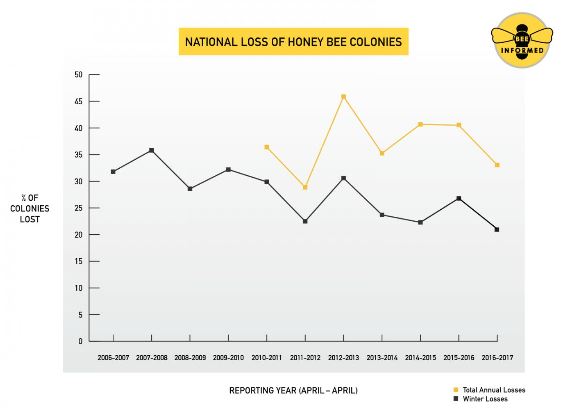College Park, Maryland, USA
May 25, 2017

This summary chart shows the results of an 11-year annual survey that tracks honey bee colony losses in the United States, spanning 2006-2017. Credit: University of Maryland/Bee Informed Partnership
Beekeepers across the United States lost 33 percent of their honey bee colonies during the year spanning April 2016 to April 2017, according to the latest preliminary results of an annual nationwide survey. Rates of both winter loss and summer loss--and consequently, total annual losses--improved compared with last year.
Total annual losses were the lowest since 2011-12, when the survey recorded less than 29 percent of colonies lost throughout the year. Winter losses were the lowest recorded since the survey began in 2006-07.
The survey, which asks both commercial and small-scale beekeepers to track the survival rates of their honey bee colonies, is conducted each year by the nonprofit Bee Informed Partnership in collaboration with the Apiary Inspectors of America. Survey results for this year and all previous years are publicly available on the Bee Informed website.
"While it is encouraging that losses are lower than in the past, I would stop short of calling this 'good' news," said Dennis vanEngelsdorp, an assistant professor of entomology at the University of Maryland and project director for the Bee Informed Partnership. "Colony loss of more than 30 percent over the entire year is high. It's hard to imagine any other agricultural sector being able to stay in business with such consistently high losses."
Beekeepers who responded to the survey lost a total of 33.2 percent of their colonies over the course of the year. This marks a decrease of 7.3 percentage points over the previous study year (2015-16), when loss rates were found to be 40.5 percent. Winter loss rates decreased from 26.9 percent in the previous winter to 21.1 percent this past winter, while summer loss rates decreased from 23.6 percent to 18.1 percent.
The researchers noted that many factors are contributing to colony losses, with parasites and diseases at the top of the list. Poor nutrition and pesticide exposure are also taking a toll, especially among commercial beekeepers. These stressors are likely to synergize with each other to compound the problem, the researchers said.
"This is a complex problem," said Kelly Kulhanek, a graduate student in the UMD Department of Entomology who helped with the survey. "Lower losses are a great start, but it's important to remember that 33 percent is still much higher than beekeepers deem acceptable. There is still much work to do."
The number one culprit remains the varroa mite, a lethal parasite that can easily spread between colonies. Mite levels in colonies are of particular concern in late summer, when bees are rearing longer-lived winter bees.
In the fall months of 2016, mite levels across the country were noticeably lower in most beekeeping operations compared with past years, according to the researchers. This is likely due to increased vigilance on the part of beekeepers, a greater availability of mite control products and environmental conditions that favored the use of timely and effective mite control measures. For example, some mite control products contain essential oils that break down at high temperatures, but many parts of the country experienced relatively mild temperatures in the spring and early summer of 2016.
This is the 11th year of the winter loss survey, and the seventh year to include summer and annual losses. More than 4,900 beekeepers from all 50 states and the District of Columbia responded to this year's survey. All told, these beekeepers manage about 13 percent of the nation's estimated 2.78 million honey bee colonies.
The survey is part of a larger research effort to understand why honey bee colonies are in such poor health, and what can be done to manage the situation. Some crops, such as almonds, depend entirely on honey bees for pollination. Honey bees pollinate an estimated $15 billion worth of crops in the U.S. annually.
"Bees are good indicators of the health of the landscape as a whole," said Nathalie Steinhauer, a graduate student in the UMD Department of Entomology who leads the data collection efforts for the annual survey. "Honey bees are strongly affected by the quality of their environment, including flower diversity, contaminants and pests. To keep healthy bees, you need a good environment and you need your neighbors to keep healthy bees. Honey bee health is a community matter."
A summary of the 2016-2017 survey results is available upon request prior to May 25, 2017; thereafter the results will be added to previous years' results publicly available on the Bee Informed Partnership's website.